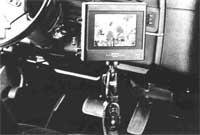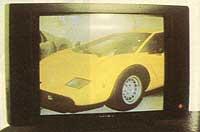New TV screens
1991/06/01 Otaolaurretxi, Jon Iturria: Elhuyar aldizkaria
From here to fifteen years, XXI. At the beginning of the 20th century it will be normal that in the houses there are screens much larger and thinner than in the wall of the room. They will have an approximate area of square meters and will be proportionally wider than the current ones. The quality of the images, on the other hand, will have no film envy.
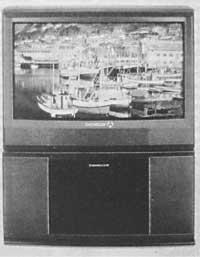
The light image, the giant screen and the fact that television is a very fine receiver are the three main advantages that will be offered in the future for any viewer. The first thing that will reach us in all three will be High Definition Television (BHTB or HDTV), which is expected to be technically expanded next year. Programs are already being created as high definition, but international standards for the production and transmission of those images will have to be put into effect, even if the deadline is not clear.
Images in high definition
However, some current rules are known. The image will be four times more accurate than now, with 625 lines in Europe by 1,250 and in Japan by 530 by 1,125. In addition, in each line the number of points will be double.
TV manufacturers have already begun to compete to sell TVs that broadcast high-definition images. Through 1,250 lines (1,125 in Japan) they achieve unprecedented image quality on television, although the programs have not yet been created and broadcast according to HD standards. For this they have a computer mechanism and what it does is, said schematically, repeat a line between two real lines that arrive through memori circuits. In total, 1,250 lines are offered to the viewer and when the program is transmitted in 1,250 lines over time, it will suffice to place a decoder.
The decoder is not yet willing to be purchased by any customer in stores, but is expected to be marketed for next year. At the Barcelona Olympics they want to create and transmit high-definition images.
In the manufacture of near-high-definition televisions, Thomson (in Europe) and Sony (in Japan) have been the first, with an approximate cost of 600,000 pesetas per device. It seems that these households are launching their products too quickly on the subject of HD television, since it would be logical that, after deciding first the production and transmission of HD programs, they would produce receivers.
In its beginnings, first generation HD TVs will be different from the current ones. The proportion of the dimensions of the screen will be 16/9 (proportion between width and height) and not 4/3 of the current. They will be, therefore, wider, those who approach more the proportion of the cinema screen or the visual field of the person. In this way, television images will be “more natural”.
These televisions will undergo many technical changes. For example, in the cathodic tube, where signals received from the antenna become luminous images. In this tube an electron beam sweeps or linearly wipes the photoluminescent layer inside the screen. To get a light image, the electron beam in the HD tube must be finer while maintaining the same brightness. To do this, the electrical voltage in the HD tube is 15% higher than the conventional voltage.
Consequently, engineers have had to get a screen to withstand a more violent electronic bombardment. This is a fundamental problem for the image to finally have brightness and contrast. In front of the inner surface of the screen is the perforated metal plate. Select the three basic colors and launch them to the screen with more power. In practice, the electrons of each of the three tube cannons (those corresponding to green, blue and red) are oriented so that one of the three luminescent substances on the screen reaches only one.
The European Philips and the Japanese Matsushita have achieved an iron and nickel plate (made of “invar” steel). It supports electron bombardment without expanding sharply and without heating the high emission power.
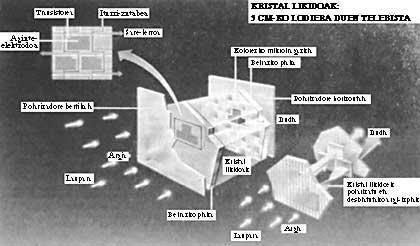
Giant screens
The thin figures of 1,125 lines are expected to give a trend to the giant screen. In current conditions, the truth is that people have not shown fondness for the big screen. According to the results of a survey conducted in 1986, 55% were not fond of large screens, while in France giant screens are sold less and less. The reason is that with 625 lines the image quality on the large screen is poor, but according to studies conducted at the Thomson house, on HD television, four times more accurate, a diagonal screen of 1.72 meters would offer the viewer good quality images.
However, in the diagonal cathodic tube above a meter, the weight of the glass and the depth of the television are enormous: They weigh 170 kilos and pass right through the doors of the house.
To avoid this problem and to be able to visualize the images in high definition on giant screens, the solution consists in the retroprojection of the images from the projection tubes of small size. This system has been used to obtain large format images on conventional televisions. It is true that the device is somewhat larger, but it is also lighter and smaller in depth. Lighter, due to the smaller amount of glass the tube has, and lower depth, because light rays have a zigzag path to the transparent screen.
Thomson has developed a system of three tubes (one for each basic color) of 23 centimeters in diameter on high definition screens of 1.80 diagonal meters.
Although weight and size problems are lower than in conventional ducts, in large format limits appear soon. Therefore, the liquid crystal miniscreens used in miniature TVs are very attractive. The screens of this system can be very thin (three centimeters thick), since the image is produced point by point on the screen itself. Each of these points is turned on or off by ordering the transistor engraved on a thin layer of silicon located on a glass plate. The light points that make up the image are modulated by the liquid crystals that cover them. These crystals modify the molecular structure according to the intensity of the electric field that crosses them. As a result of this change the refractive index of the crystal is modified, modulating the emitted light.
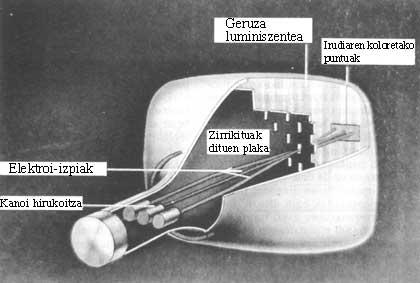
To complete the color image, the light passes through three blue, green and red microfilters. Microfilters are placed especially after liquid crystals. The trio of the three basic colors is in front of three consecutive transistors and each trio forms a color point of the image.
However, the difficulties in the manufacture of liquid crystal screens (otherwise, more than one could have saturated the market) are two main barriers with which engineers are located: on the one hand, in these screens the resolution of images is not good and, on the other, they cannot get diagonal screens greater than 14 centimeters. Many microtransistors must be placed (6,000 transistors per square centimeter), the interconnections are very numerous and the silicon layer on the glass must be very uniform. The Japanese are the ones who have the most experience in the manufacture of liquid glass screens, but they say that one of the two screens in manufacturing has to go to the bin for errors.
Engineers want to get giant liquid crystal screens on HD TV, but for now only use small screens, projecting the image back to the big screen.
Another problem is the miniaturization of microtransistors to improve resolution, and it seems that the results obtained in laboratories have been good, but it is still estimated that serial manufacturing can last between 5 and 6 years.
The last step would be to complete it directly on a thin giant screen without projecting the image. That will also be achieved, of course, but after about fifteen years. The Japanese house Seiko, however, has already prepared a prototype of 35 diagonal centimeters.

Gai honi buruzko eduki gehiago
Elhuyarrek garatutako teknologia




